| ANDROMEDA
(An-DROM-eh-da) The Princess. Genitive: Andromedae (An-DROM-eh-dee).
Abbreviation: And |
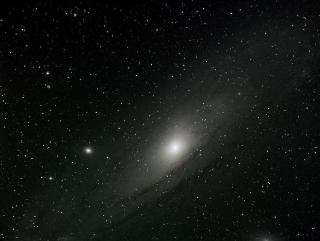 |
Andromeda Galaxy, Great Nebula in Andromeda,
M31, NGC224
Dreyer description: A magnificent (or otherwise interesting) object! Most extremely bright, extremely large, very moderately extended (Andromeda); = M31.
Magnitude: 4.0
RA: 00h 42m 44.4s
Dec: +41░16'08" (Epoch 2000)
**** Observation Log ****
So bright, this is a naked-eye galaxy! A remarkable object indeed. Best
viewed in the fall. And best viewed with a wide-angle eyepiece.
**** Observation Log
10/22/2003****
From a very clear dark-sky sight this galaxy is indeed a naked-eye target.
Through the binoculars the extent of this galaxy is astonishing! It
covered the entire view of my 7 X 10 binoculars!
**** Image Log 03/05/2011****
This image is a stack of 3 x 5 minute, one-shot color, images with an
ST-8300C through a TeleVue TV-102 APO refractor working at f/6.9. Click on
the image for a larger version. |
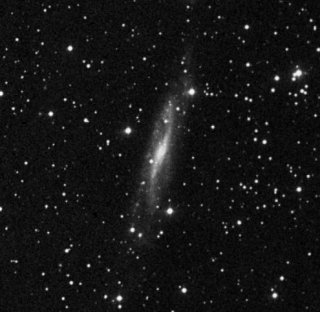 |
NGC 7640
Other description: Very elongated galaxy.
Constellation: And
Dreyer description: Considerably faint, large, moderately extended 164░, very little brighter middle, resolvable, but mottled.
Magnitude: 10.9
RA: 23h 22m 06.0s
Dec: +40░51'00" (Epoch 2000)
**** Observation Log ****
11/2001 - Found this finally. The author from Sky and Telescope« states this as an elusive galaxy. I would say that's somewhat of an understatement. Boy oh Boy, is this object hard to see. With our 8" scope this was an extremely faint haze with absolutely no structure. My advice... Don't bother with anything less than a 12"
visually unless you have an extremely dark sky. It was fun though to hunt down though.. We locked it in at RA 23║ 20.3' DEC +40║ 51.0'.
This galaxy is best viewed in the fall. |
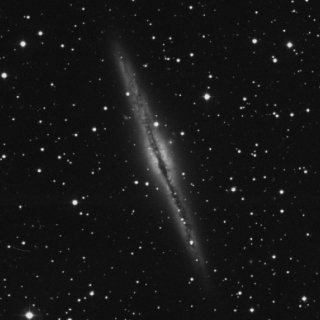 |
NGC 891
Other description: Edge on galaxy dusty.
Constellation: And
Dreyer description: Remarkable! Bright, very large, very moderately extended 22░.
Magnitude: 10.0
RA: 02h 22m 59.0s Dec: +42░22'45"
RA: 02h 22m 36.0s Dec: +42░21'00" (Epoch 2000)
**** Observation Log ****
Another tough galaxy in Andromeda. I have spotted this with a 4"
refractor as a thin barely visible needle. Images of this galaxy are
stunning! Very reminiscent of NGC 4565 in Coma Berenices. |
 Back to top...
Back to top... |
|
|
CANES VENATICI (KAY-neez Ve-NAT-i-sy) The
Hunting Dogs. Genitive: Canum Venaticorum (KAY-num Ve-NAT-i-kor-um). Abbreviation:
CVn |
 |
Whirlpool Galaxy ,M51, NGC5194
Dreyer description: A magnificent (or otherwise interesting) object!, great spiral nebula M51.
Magnitude: 9.2
RA: 13h 29m 53.3s
Dec: +47░11'48" (Epoch 2000)
**** Observation Log ****
04/2002 - The Whirlpool Galaxy in Canes Venatici. The absolute most stunning
view I've ever had of this marvel. I could see the structure of M51 and it's
close companion. Worth a year's worth of anything! WOW! Had to call it a
night on this one. The famous Whirlpool galaxy in Canes Venatici is a bright face on spiral with a smaller eliptical companion, NGC 5195. Look for a pair of fuzzy patches of light. The slightly larger and brighter one is M51. Make sure to spend some time here as there is almost always some spiral structure to be seen, on good nights the detail possible is unbelievable. This is a difficult but very possible object in binoculars appearing as a hazy patch of light.
Perhaps the most
famous HST image ever at APOD
06/22/04 - From a great dark sky site with a 30" Dob, this wonder
was a site to behold. The spiral structure was great! |
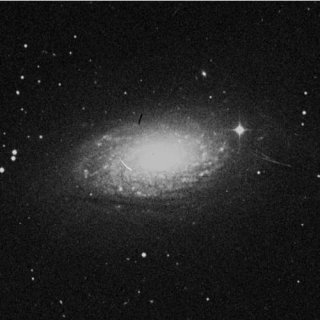 |
Sunflower Galaxy , M63, NGC 5055
Dreyer description: Very bright, large, westward moderately extended 120░ +/-, very abruptly much brighter middle bright nucleus; = M63.
Magnitude: 9.6
RA: 13h 15m 49.3s
Dec: +42░02'06" (Epoch 2000)
**** Observation Log ****
04/2002 - The Sunflower Galaxy in Canes Venatici. You can just
make out some structure in larger instruments. Not as easy as M64 the
Black-eye galaxy
|
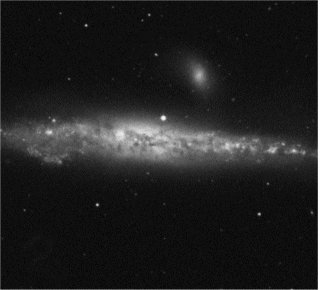 |
Common Name: Whale Galaxy, NGC 4631
Very elongated galaxy,dust & bright knots. APOD
Image
Constellation Canis Venatici
Magnitude: 9.30
RA: 12h 42m 6.0s , Dec: 32d 32m 0s N (E2000)
**** Observation Log ****
|
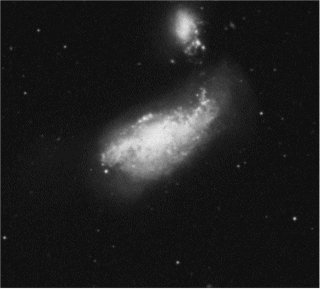 |
Common Name: Cocoon Galaxy, NGC 4490
Spiral galaxy structure attached companion.
Constellation Canis Venatici
Magnitude: 9.80
RA: 12h 30m 36.0s , Dec: 41d 38m 0s N (E2000)
**** Observation Log ****
|
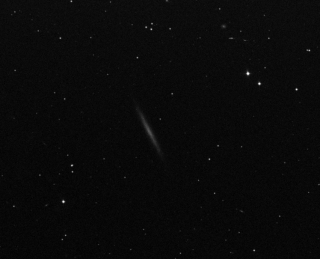
|
NGC 5023
Other description: Edge on galaxy.
Constellation: CVn
Dreyer description: Pretty faint, large, moderately extended 20░, very little brighter middle.
Magnitude: 12.0
RA: 13h 12m 12.0s Dec: +44░02'00" (Epoch 2000)
Azm: 292░22'48" Alt: +59░49'40"
**** Observation Log ****
6/23/2009 - Difficult object to find! Pretty close to
M51. This galaxy appears as a sliver framed by a thin. long triangle
of stars above and below. This bulge-less edge on galaxy is quite
an accomplishment to hunt down. In our 16" looks like a long
dim smudge.
|
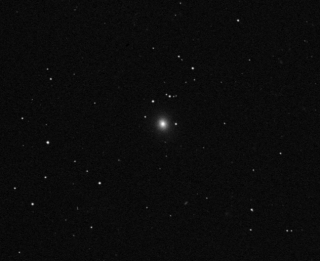
|
NGC 5198
Other description: Round galaxy with bright core.
Constellation: CVn
Dreyer description: Pretty faint, pretty small, round, much brighter middle.
Magnitude: 13.0
RA: 13h 30m 12.0s Dec: +46░40'00" (Epoch 2000)
**** Observation Log ****
6/23/2009 - Very close to M 51 and shares the same FOV with a very low
power eye-piece although you need some serious aperture to be aware of
it. With our 16" Dob, was very easy to spot. Appears as a fuzzy
oval with a brighter core. Nudging just west-southwest is the is the
galaxy pair NGC 5173 and 5169 making this a wonderful trio of galaxies
to hunt down.
|
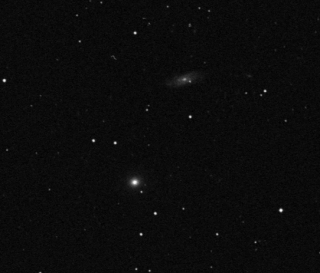
|
NGC 5173
Other description: Round galaxy in group.
Constellation: CVn
Dreyer description: Faint, very small, round, stellar.
Magnitude: 13.0
RA: 13h 28m 24.0s Dec: +46░36'00" (Epoch 2000)
===========================
NGC 5169
Other description: Elongated galaxy close companion.
Constellation: CVn
Dreyer description: Very faint, pretty small, round.
Magnitude: 14.0
RA: 13h 28m 12.0s Dec: +46░40'00" (Epoch 2000)
**** Observation Log ****
6/23/2009 - Very close to M 51 and shares the same FOV with a very low
power eye-piece although you need some serious aperture to be aware of
it. With our 16" Dob, was very easy to spot. NGC 5173 is the
brighter of the two to the lower center in this image with NGC 5169
above and to the right. NGC 5169 is just a wisp in our 16" Dob.
|
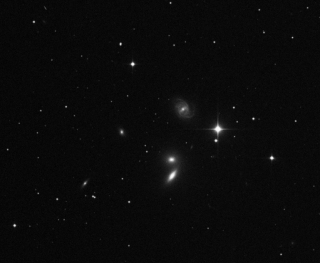
|
Hickson 68 Galaxy Group:
NGC5350
Magnitude: 12.4
RA: 13h 53m 21.5s Dec: +40░21'48" (Epoch 2000)
NGC5354
Magnitude: 12.5
RA: 13h 53m 26.6s Dec: +40░18'16" (Epoch 2000)
NGC5353
Magnitude: 12.4
RA: 13h 53m 26.8s Dec: +40░17'03" (Epoch 2000)
**** Observation Log ****
6/23/2009 - This group is a wonderful tight pack to hunt down. The
bright K type star (to the right of the group) makes it easy to find.
The interacting pair NGC 5394 and 5353 are beautiful to behold. NGC 5350
has a distinct oval shape.
|
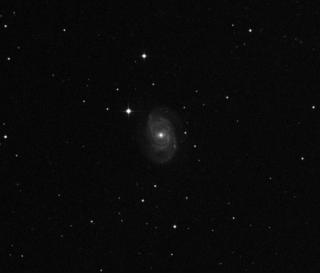
|
NGC 5371
Other description: Round galaxy with bright core.
Constellation: CVn
Dreyer description: Pretty bright, large, round, brighter middle faint nucleus.
Magnitude: 10.8
RA: 13h 55m 42.0s Dec: +40░28'00" (Epoch 2000)
**** Observation Log ****
6/23/2009 - This wonderful spiral is easy to spot in the 16" Dob.
The spiral structure is just discernable. Lovely galaxy more that 100
million light years distant.
|
|
Back to top... |
|
| CEPHEUS
(SEE-fee-us) The King. Genitive: Cephei (See-fee-eye). Abbreviation: Cep |
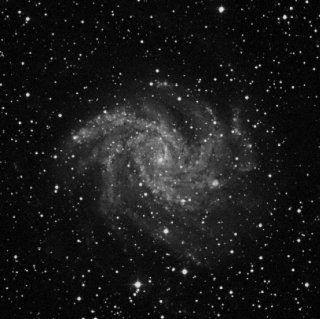 |
NGC 6946, UGC11597,
MCG10-29-6, CGCG304-6, PGC65001
Dreyer description: Very faint, very large, very gradually, very abruptly brighter middle, partially resolved.
Magnitude: 9.9
RA: 20h 34m 58.7s Dec: +60░10'21"
RA: 20h 34m 51.9s Dec: +60░09'15" (Epoch 2000)
A
**** Observation Log ****
A rather challenging object in smaller scopes due to it low surface
brightness. In the same low-power FOV as the Open Cluster
NGC 6939. This galaxy must have dark skies to even view. It looks like a
slightly oval nebular patch. With careful scrutiny you can just make out
the nucleus with averted vision. There are three stars that form a
triangle that the apex of the triangle points almost directly at the
nucleus. |
 Back to top...
Back to top... |
|
| CETUS
(SEE-tus) The Whale. Genitive: Ceti (SEE-ti). Abbreviation: Cet |
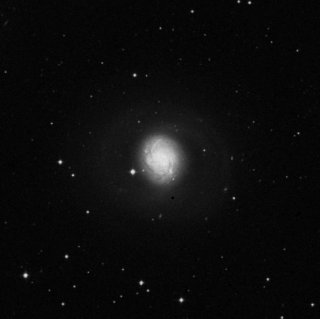 |
M77, NGC 1068
Dreyer description: Very bright, pretty large, irregularly round, abruptly
brighter middle partially resolved nucleus; = M77.
Magnitude: 9.6
RA: 02h 42m 40.2s Dec: -00░00'48"
**** Observation Log ****
One of the two Seyfert Galaxies in the Messier catalog. Seyfert galaxies are usually (but not always) spirals with very bright (almost starlike) nuclei, They exhibit a strong continuum from IR through X-ray regions of the spectrum, with emission lines that are sometimes variable. Seyfert galaxies have been among the most intensively studied objects in astronomy, primarily because they are thought to be nearby, low-luminosity versions of the same phenomenon observed in quasars. A massive black hole in the nucleus of a galaxy, accreting gas from its surrounding environment, is thought to power all these objects. Of course, we do not see the black hole itself, but the UV continuum radiation is generally presumed to be thermal emission from the hot gas that forms an accretion disk surrounding the black hole. |
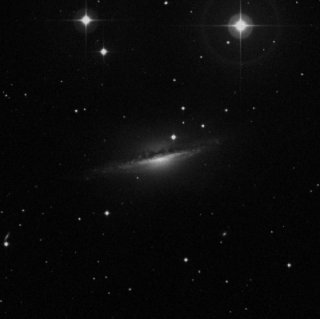 |
NGC 1055
Other description: Very elongated galaxy.
Constellation: Cetus
Dreyer description: Pretty faint, considerably large, irregular extended
80░, brighter middle, 11th magnitude star north 1'.
Magnitude: 10.6
RA: 02h 41m 56.7s Dec: +00░26'40"
RA: 02h 41m 48.0s Dec: +00░26'00"
**** Observation Log ****
Sue French in January 2002 S&T asks the question, is this a Celestial
Smirk? |
 Back to top...
Back to top... |
|
|
COMA BERENICES (KO-ma Be-ren-EYE-Seez)
Berenice's Hair. Genitive: Comae Berenices (KO-me Be-ren-EYE-seez), Abbreviation:
Com |
 |
Black-eye Galaxy, M64, NGC 4826
Dreyer description: Remarkable! Very bright, very large, very moderately extended 120░ +/-, brighter middle small bright nucleus; = M64.
Magnitude: 8.7
RA: 12h 56m 44.3s
Dec: +21░41'05" (Epoch 2000)
**** Observation Log ****
04/2002 - The Black-eye Galaxy or Sleeping Beauty galaxy in Coma Berenices.
Wonderful what dark skies can do. I could definitely see the the black lane
that is the signature for this wonderful sight. In this photo, look just
above the center for the "black-eye". |
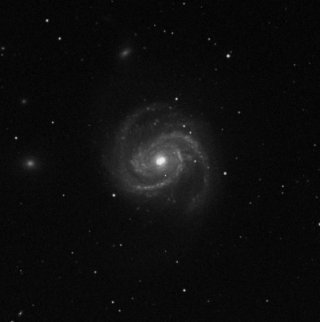 |
M100, NGC 4321
Constellation: Com
Dreyer description: Very remarkable! Pretty faint, very large, round, very gradually, pretty abruptly brighter middle resolvable, but mottled nucleus, 2-branched spiral; = M100.
RA: 12h 22m 55.2s Dec: +15░49'23" (Epoch 2000)
**** Observation Log ****
|
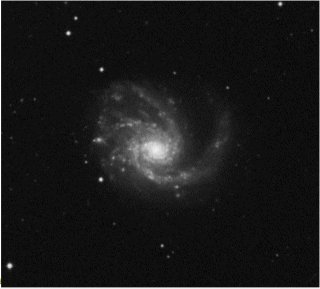 |
Pin-wheel Nebula, M99 , NGC 4254
Spiral galaxy structure.
Constellation Coma Berenices
Magnitude: 9.80
RA: 12h 18m 48.0s , Dec: 14d 25m 0s N (E2000)
**** Observation Log ****
|
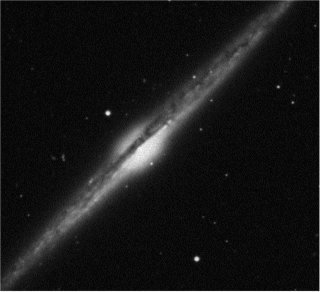 |
NGC 4565
Edge on galaxy dusty. APOD
Image
Constellation Coma Berenices
Magnitude: 9.60
RA: 12h 36m 18.0s Dec: 25d 59m 0s N (E2000)
**** Observation Log ****
Perhaps one of the most beautiful and photogenic edge-on spiral galaxies in
the entire sky.
06/22/04 - From NMSkies with a 30" Dob, This was incredible! The dark
lane almost had a 3D quality to it. The view was almost exactly what you see
to the right!
|
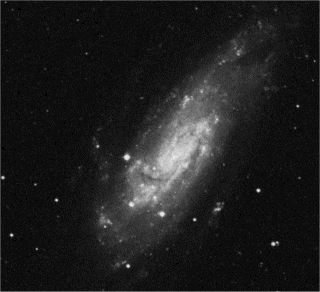 |
NGC 4559
Elongated galaxy.
Constellation Coma Berenices
Magnitude: 9.90
RA, Dec: 12h 36m 6.0s , 27d 57m 20s N
Az, Alt: 219d 7m 8s , 75d 46m 19s N
Rise:13h 51m Transit:21h 38m Set: 5h 28m
Source Catalog NGC
Size (mins) 12.0 x 5.0
Position Angle 150.0
RA, Dec: 12h 36m 0.0s , 27d 58m 0s N (E2000)
**** Observation Log ****
|
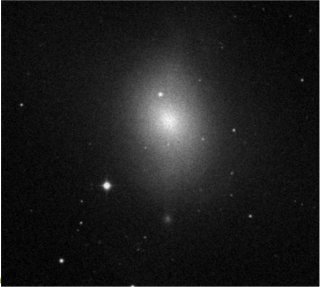 |
M85, NGC 4382
Dreyer description: Very bright, pretty large, round, brighter middle, star northwest; = M85.
Other ID: UGC7508
Other ID: MCG3-32-29
Other ID: MESS85
Other ID: PGC40515
Magnitude: 10.0
RA: 12h 25m 36.6s Dec: +18░10'02"
RA: 12h 25m 24.6s Dec: +18░11'27" (Epoch 2000)
**** Observation Log ****
|
 |
NGC 4394
Other description: Round galaxy.
Constellation: Com
Dreyer description: Pretty bright, little extended, brighter middle.
Magnitude: 10.9
RA: 12h 26m 06.0s Dec: +18░11'34"
RA: 12h 25m 54.0s Dec: +18░13'00" (Epoch 2000)
**** Observation Log ****
|
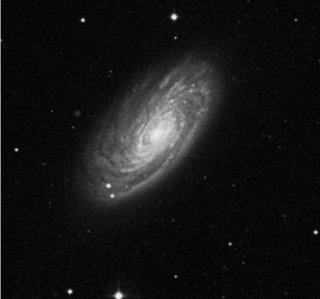 |
M88
NGC 4501
Dreyer description: Bright, very large, very moderately extended; = M88.
Other ID: UGC7675
Other ID: MCG3-32-59
Other ID: MESS88
Other ID: PGC41517
Magnitude: 10.3
RA: 12h 32m 11.5s Dec: +14░23'53"
RA: 12h 31m 59.6s Dec: +14░25'17" (Epoch 2000)
**** Observation Log ****
|
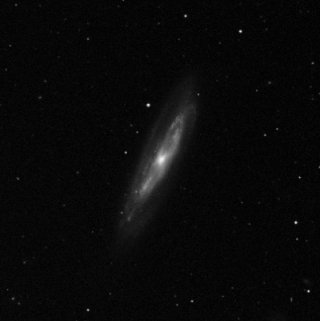 |
M98, NGC 4192
Dreyer description: Bright, very large, very moderately extended 152░, very abruptly very much brighter middle; = M98.
RA: 12h 13m 48.2s Dec: +14░53'43" (Epoch 2000)
**** Observation Log ****
|
 Back to top...
Back to top... |
|
| CORVIS
(KOR-vus) The Crow. Genitive: Corvi (KOR-vi). Abbreviation: Crv |
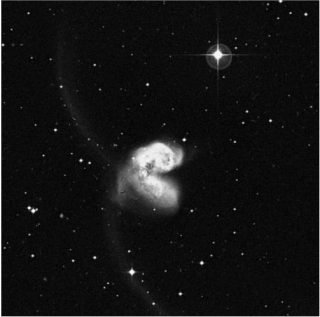 |
Common Name: Antennae Galaxy,
NGC 4038, 4039
Elongated galaxy close companion, in collision. APOD
Image
Constellation Corvis
Magnitude: 10.70
RA, Dec: 12h 1m 54.0s , 18d 52m 0s S (E2000)
**** Observation Log ****
05/2002 -
|
 Back to top...
Back to top... |
|
|
DRACO (DRAY-ko) The Dragon. Genitive:
Draconis (DRAY-Ko-nis). Abbreviation: Dra |
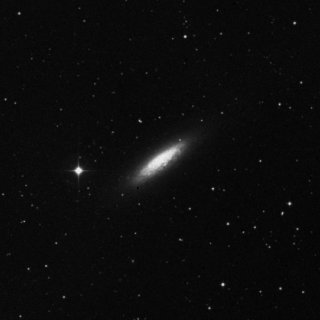 |
NGC 6503
Other description: Elongated galaxy dusty.
Constellation: Dra
Dreyer description: Bright or pretty bright, large, moderately extended, 9th magnitude star eastward 4'.
Magnitude: 10.2
RA: 17h 49m 26.0s Dec: +70░08'49"
RA: 17h 49m 24.0s Dec: +70░09'00" (Epoch 2000)
**** Observation Log ****
A wonderful bright galaxy. Can even be glimpsed under a full moon as we
did on this night. The bright 8th magnitude star to the south of the
galaxy is an easy pointer star to find this galaxy.
|
 Back to top...
Back to top... |
|
| FORNAX
(FOR-naks) The Furnace. Genitive: Fornacis (FOR-na-cis). Abbreviation: For |
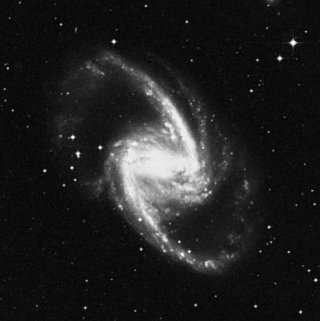 |
NGC 1365
Dreyer description: Very remarkable! Very bright, very large, moderately extended, resolvable, but mottled nucleus.
Magnitude: 10.1
RA: 03h 33m 42.1s Dec: -36░07'45"
RA: 03h 33m 36.6s Dec: -36░08'17" (Epoch 2000)
**** Observation Log ****
|
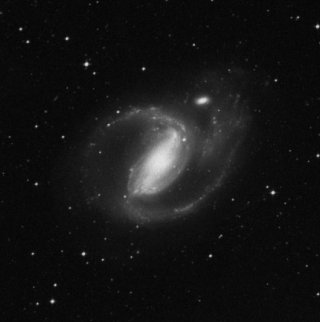 |
NGC 1097
Other description: Very elongated galaxy close companion.
Constellation: For
Dreyer description: Very bright, large, very moderately extended 151░, very brighter middle nucleus.
Magnitude: 9.3
RA: 02h 46m 31.6s Dec: -30░15'42"
RA: 02h 46m 18.0s Dec: -30░17'00" (Epoch 2000)
**** Observation Log ****
|
 Back to top...
Back to top... |
|
|
LEO (LEE-oh) The Lion. Genitive: Leonis
(LEE-oh-nis), Abbreviation: Leo |
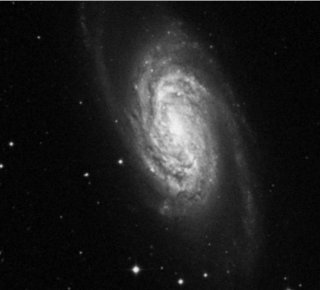 |
NGC 2903
Other description: Elongated galaxy dusty.
Dreyer description: Considerably bright, very large, extended, gradually much brighter middle, resolvable, but mottled, southwest of 2.
Magnitude: 8.9
RA: 09h 32m 12.0s
Dec: +21░30'00" (Epoch 2000)
**** Observation Log ****
04/2003 - Very bright face-on spiral. Easy target for almost any small
telescope just off the "front" top of the Lion's mane. |
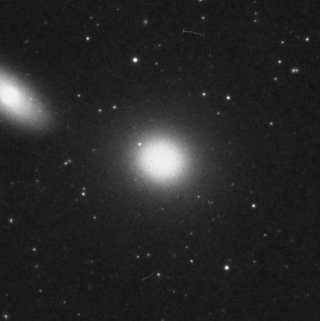 |
M105 , NGC 3379
Dreyer description: Very bright, considerably large, round, pretty abruptly brighter middle, resolvable, but mottled; = M105.
Magnitude: 10.1
RA: 10h 47m 49.8s
Dec: +12░34'57" (Epoch 2000)
**** Observation Log -
04/2002 ****
Revisiting these galaxies in Leo. Brightest elliptical galaxy in
the Leo I group. Can see ok in the 8". Neat little fuzzy ball.
03/29/2003 - NGC 3384 and NGC 3389 are in the same FOV, creating a triangle
of galaxies. The M96 groups brightest elliptical galaxy. NGC 3379 the
M96 groups brightest elliptical galaxy. |
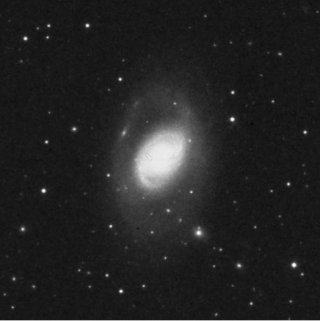 |
M96 , NGC 3368
Dreyer description: Very bright, very large, little extended, very abruptly very much brighter middle, resolvable, but mottled; = M96.
Magnitude: 9.9
RA: 10h 46m 45.2s
Dec: +11░49'16" (Epoch 2000)
**** Observation Log ****
Also known as NGC 3368 in Leo. Wonderful spiral galaxy with bright core.
Brightest of the area's galaxies, so the group of galaxies in the area is
called the M96 group.
|
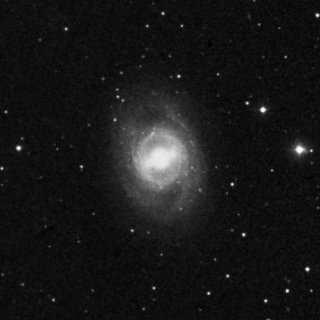 |
M95, NGC 3351
Dreyer description: Bright, large, round, pretty gradually much brighter middle nucleus; = M95.
Magnitude: 10.7
RA: 10h 43m 58.0s
Dec: +11░42'15" (Epoch 2000)
**** Observation Log ****
03/2002 - NGC 3351 in Leo. A barred spiral with a bright core. Can see a
wisp of the bar structure in an 8" scope. This galaxy in Leo appears as a faint round patch of light with a bright nucleus. |
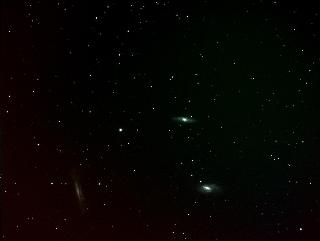 |
M65, NGC3623 - Leo Triplet
Dreyer description: Bright, very large, moderately extended 165░ +/-,
gradually brighter middle bright nucleus; = M65. Magnitude: 10.1RA: 11h
18m 55.2s Dec: +13░05'35" (Epoch 2000)
Size: 9.7' x 2.8'
-----
M66, NGC3627 - Leo Triplet
Dreyer description: Bright, very large, moderately extended 150░, much
brighter middle, 2 stars northwest; = M66. Magnitude: 9.6 RA: 11h 20m
14.4s Dec: +12░59'42" (Epoch 2000)
Size: 9.2' x 4.2'
-----
NGC3628 - Leo Triplet (far left)
Dreyer description: Pretty bright, very large, very moderately extended
102░. Magnitude: 10.5 RA: 11h 20m 16.2s Dec: +13░35'22" (Epoch 2000)
Size:14.7' x 2.9
*****Image Log****
3/9/2011 - This is a stack of 3 x 10 minute single shot color with an
ST-8300C through a TeleVue TV-102 working at f/6.9. Click on the image
for a larger version. |
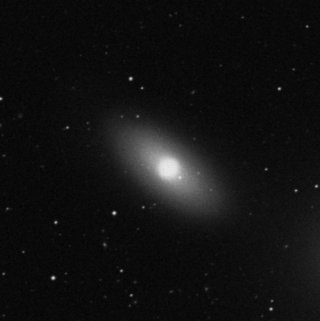 |
NGC 3384
Other description: Round galaxy with bright core.
Dreyer description: Very bright, large, round, westward abruptly much brighter middle, 2nd of 3.
Magnitude: 10.0
RA: 10h 48m 18.0s Dec: +12░38'00" (Epoch 2000)
**** Observation Log ****
03/2002 - Elliptical galaxy with bright core. Image from the Digital Sky
Survey. |
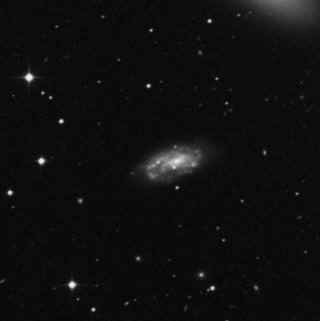 |
NGC 3389
Other description: Very elongated galaxy in group.
Dreyer description: Faint, large, extended east-west, very gradually little brighter middle, 3rd of 3.
Magnitude: 11.8
RA: 10h 48m 30.0s Dec: +12░32'00" (Epoch 2000)
**** Observation Log ****
03/2002 - Very elongated galaxy in group. Tough one to see. Very small and
faint. |
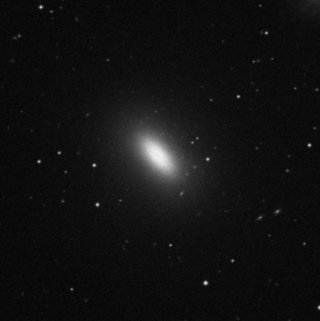 |
NGC 3377
Other description: Elongated galaxy with bright core.
Dreyer description: Very bright, considerably large, little extended, abruptly very much brighter middle bright nucleus.
Magnitude: 10.2
RA: 10h 47m 42.0s Dec: +13░59'00" (Epoch 2000)
**** Observation Log ****
03/2002 - Elongated galaxy with bright core. Supposed to contain a massive
Black Hole in the center of it. |
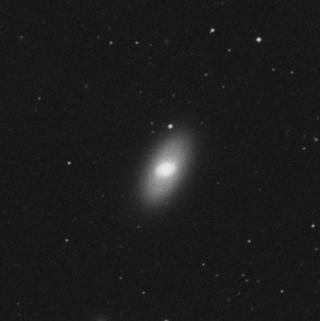 |
NGC 3412
Other description: Elongated galaxy with bright core.
Dreyer description: Bright, small, little extended 135░ +/-, abruptly much brighter middle nucleus.
Magnitude: 10.6
RA: 10h 50m 54.0s Dec: +13░25'00" (Epoch 2000)
**** Observation Log ****
03/2002 - Elongated galaxy with bright core. Could see the core which is very bright.
|
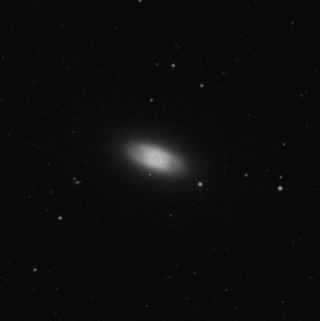 |
NGC 3489
Other description: Round galaxy with bright core.
Dreyer description: Very bright, pretty large, little extended 80░ +/-, abruptly much brighter middle nucleus.
Magnitude: 10.3
RA: 11h 00m 18.0s Dec: +13░54'00" (Epoch 2000)
**** Observation Log ****
Very tough object to see.
Brighter core with barely visible oval structure. |
 Back to top...
Back to top... |
|
| LYNX
(Links) The Lynx or Bobcat. Genitive: Lyncis (LIN-sis). Abbreviation: Lyn |
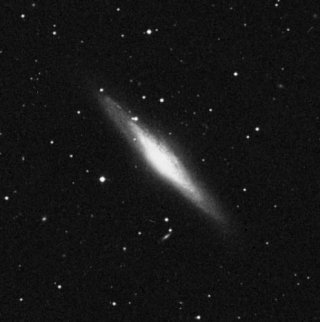 |
NGC 2683
Other description: Very elongated galaxy, dusty, bright core.
Constellation: Lyn
Dreyer description: Very bright, very large, very moderately extended 39░, gradually much brighter middle.
Magnitude: 9.7
RA: 08h 52m 42.0s
Dec: +33░25'00" (Epoch 2000)
**** Observation Log ****
04/2002 - Very elongated galaxy, dusty, bright core in the constellation
Lynx. This is one of the late-winter, very early-spring galaxies. |
 Back to top...
Back to top... |
|
| PEGASUS
(PEG-a-sus) The Winged Horse. Genitive: Pegasi (PEG-a-si). Abbreviation:
Peg |
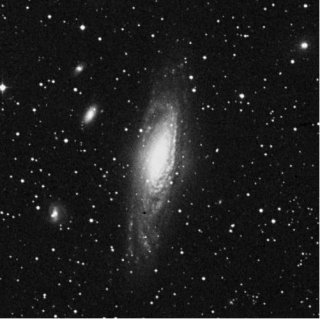 |
Deer Lick Group, NGC 7331
Other description: Very elongated galaxy, dusty, bright core.
Constellation: Peg
Dreyer description: Bright, pretty large, westward moderately extended 163░, abruptly much brighter middle.
Magnitude: 9.5
RA: 22h 37m 06.0s
Dec: +34░25'00" (Epoch 2000)
**** Observation Log ****
11/2001 - Got this one! This galaxy resolves as an elongated fuzz ball
with a bright core. What a beautiful sight! The smaller galaxies were not
visible in the 8". This galaxy is the largest member of the Deer Lick
group. A grouping of galaxies in Pegasus. The rest of the members are
challenging visually. |
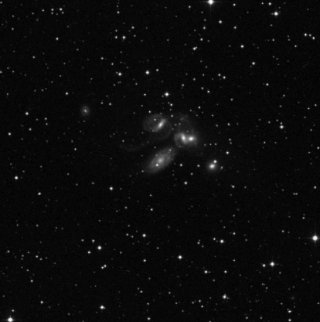 |
Stephan's Quintet
, NGC 7317
Description: Famous group of five galaxies.
Sky Database: Common Non-Stellar
RA: 22h 36m 07.4s Dec: +33░58'24"
RA: 22h 35m 54.0s Dec: +33░57'00" (Epoch 2000)
**** Observation Log ****
08/20/2004 - This is a very challenging visual group of galaxies. I was
able to nab this in a 10' Newtonian from a dark-sky site. Appears as not
quite pin-point stars visually. No structure from the galaxies was visible. |
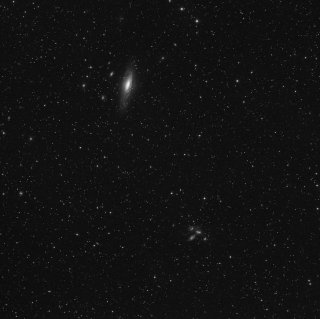 |
Deer Lick Group and Stephan's Quintet
Equatorial: RA: 22h 36m 47s Dec: +34░12'50"(current)
Equatorial 2000: RA: 22h 36m 34s Dec: +34░11'18"
**** Observation Log ****
This is such an interesting group of galaxies that here is a wide field
view. You can get both in a low power view. You must be at a dark sky site
however to have a chance at the dim Stephen's Quintet. |
 Back to top...
Back to top... |
|
| PERSEUS
(PUR-see-us) The Hero. Genitive: Persei (PUR-see-eye). Abbreviation: Per |
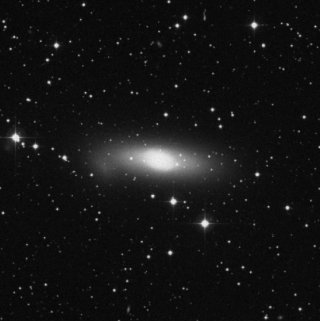 |
NGC 1023
Other description: Very elongated galaxy with bright core.
Constellation: Per
Dreyer description: Very bright, very large, very moderately extended, very, very much brighter middle.
Magnitude: 9.5
RA: 02h 40m 39.0s Dec: +39░05'10"
RA: 02h 40m 24.0s Dec: +39░04'00" (Epoch 2000)
******* 9/23/2003 *******
|
 Back to top...
Back to top... |
|
| PISCES
(PIE-seez) The Fishes. Genitive: Piscium (PISH-ee-um). Abbreviation: Psc |
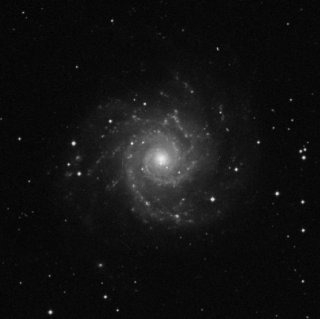 |
M74, NGC 628
Dreyer description: Globular cluster, faint, very large, round, very
gradually, westward abruptly much brighter middle, partially resolved; =
M74.
Magnitude: 10.0
RA: 01h 36m 42.0s Dec: +15░47'11"
**** Observation Log ****
A very difficult target because of the overall surface brightness.
|
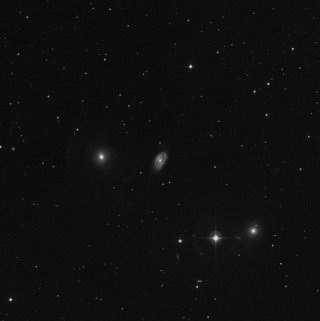 |
NGC 470 and NGC 474 and NGC 467
Other description: Very elongated galaxy brightest in group.
Constellation: Psc
Dreyer description: Pretty bright, large, irregularly round.
Magnitude: 11.9
RA: 01h 19m 57.4s Dec: +03░26'37"
RA: 01h 19m 42.0s Dec: +03░25'00" (Epoch 2000)
**** Observation Log ****
This is an odd looking object. I'm going to take a peek in on this group.
NGC 474 is a Shell Galaxy and also classified as a Lenticular. |
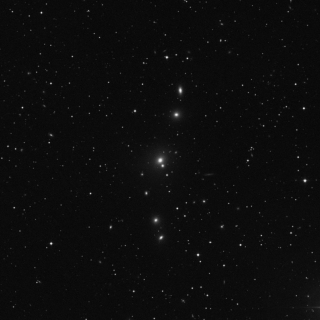 |
NGC 383 and the NGC 383 Group
of Galaxies
Other description: Round galaxy brightest in group.
Constellation: Psc
Dreyer description: Pretty faint, pretty large, round, gradually brighter middle, northeast of double nebula.
Magnitude: 11.9
RA: 01h 07m 44.1s Dec: +32░27'01"
RA: 01h 07m 24.0s Dec: +32░25'00" (Epoch 2000)
**** Observation Log ****
|
 Back to top...
Back to top... |
|
| SAGITTARIUS
(Sa-jih-TARE-ee-us) TheArcher. Genitive: Sagittarii (Sa-jih-TARE-ee-eye). Abbreviation:
Sgr |
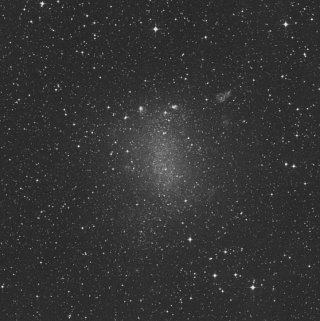 |
Barnard's Galaxy, NGC 6822
Other description: Galaxy low brightness bright knots.
Constellation: Sgr
Dreyer description: Very faint, very small, extended, diffused; = IC 4895.
Magnitude: 9.0
RA: 19h 45m 10.4s Dec: -14░47'23"
RA: 19h 44m 54.0s Dec: -14░48'00" (Epoch 2000)
**** Observation Log ****
A very elusive galaxy indeed. Usually just a mist of brighter light and
dark-skies are a must. Perhaps easier in binoculars than a telescope.
Barnard's Galaxy is a member of the local group and estimated at 1.6 million
light years distant. |
 Back to top...
Back to top... |
|
| SCULPTOR
(SKULP-tor) The Sculptor. Genitive: Sculptoris (SKULP-tor-is).
Abbreviation: Scl |
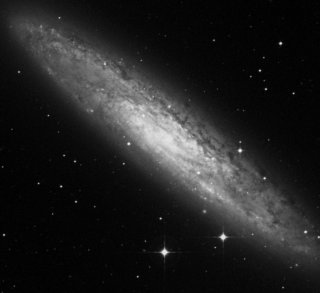 |
Sculptor Galaxy, NGC 253
Other description: Very elongated galaxy,dust & bright knots.
Constellation: Scl
Dreyer description: Very remarkable! Very, very bright, very, very large,
very moderately extended 54░, gradually brighter middle.
Magnitude: 7.1
RA: 00h 47m 44.6s Dec: -25░16'11"
RA: 00h 47m 36.0s Dec: -25░17'00" (Epoch 2000)
**** Observation Log ****
11/2002 - A rather large, easy target. The dusty bands can be glimpsed on a clear
night. |
 Back to top...
Back to top... |
|
| SEXTANS
(SEX-tans) The Sextant. Genitive: Sextantis (SEX-tan-tis). Abbreviation:
Sex |
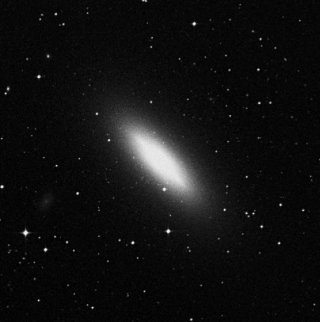 |
Spindle Galaxy, NGC 3115
Other description: Edge on galaxy with bright core.
Constellation: Sex
Dreyer description: Very bright, large, very moderately extended 46░, very gradually abruptly much brighter middle extended nucleus.
Magnitude: 9.2
RA: 10h 05m 12.0s Dec: -07░43'00" (Epoch 2000)
**** Observation Log ****
|
 Back to top...
Back to top... |
|
| TRIANGULUM
(Tri-ANG-you-lum) The Triangle. Genitive: Trianguli (Tri-ANG-you-lie).
Abbreviation: Tri |
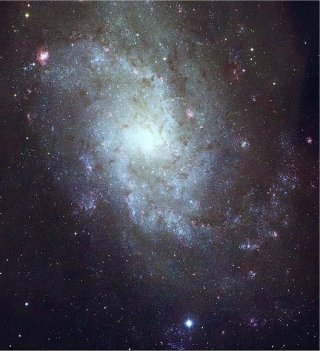 |
Pinwheel Galaxy, Triangulum Galaxy,
M33, NGC 598
Dreyer description: Remarkable! Extremely bright, extremely large, round, very gradually brighter middle nucleus; = M33.
Magnitude: 6.2
RA: 01h 33m 50.9s
Dec: +30░39'37" (Epoch 2000)
**** Observation Log ****
Visually dim spiral galaxy in Triangulum because of it's face-on
orientation. A beautiful spiral, but very hard to see unless you have a
very dark sky. Can barely make out
anything, just a wisp of faint cloudy structure. It does cover almost the
entire FOV (field of view), this object is too dim to study visually with an
8 SCT" in any kind of light polluted area. Find yourself a dark-sky
site to enjoy! Best viewed in late summer and early fall.
**** Observation Log 10/22/2003****
From a very clear dark-sky site, this was a binocular object! Clearly seen
as a large roughly round hazy path. Just beyond naked-eye, but gorgeous in
my 7 X 10 binoculars. At a dark sky site the large red nebula in the upper
left is clearly visible. |
 Back to top...
Back to top... |
|
|
URSA MAJOR (ER-sa MAY-jer) The Great Bear.
Genitive: Ursae Majoris (ER-see May-JOR-is). Abbreviation: UMa |
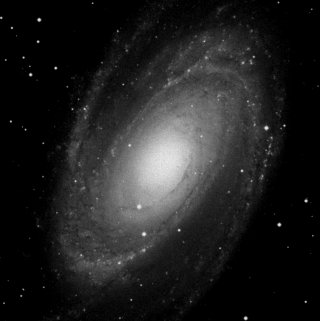 |
Bode's Nebula, , M81, NGC 3031
Dreyer description: Remarkable! Extremely bright, extremely large, extended 156░, gradually abruptly very much brighter middle bright nucleus; = M81.
Magnitude: 7.9
RA: 09h 55m 33.5s
Dec: +69░04'00" (Epoch 2000)
**** Observation Log ****
04/2002 - It's not a nebula at all, (But looked like one in Bode's
telescope) Spiral galaxy structure in the constellation Ursa Major. Lovely,
can see a wisp of structure. |
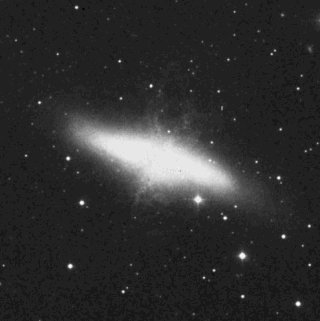 |
M82, NGC3034
Dreyer description: Very bright, very large, very moderately extended (ray); = M82.
Magnitude: 9.2
RA: 09h 56m 20.1s Dec: +69░39'21"
RA: 09h 55m 54.0s Dec: +69░40'57" (Epoch 2000)
**** Observation Log ****
This galaxy has a definite yellow cast to it. It appears as a bright streak
in the eyepiece. Both M81 and M82 can be viewed in a low power eyepiece. |
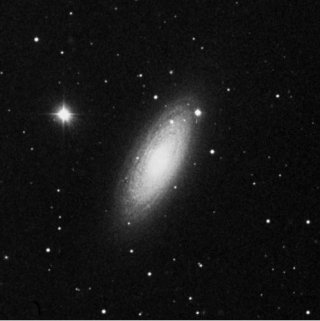 |
NGC 2841
Other description: Elongated galaxy dusty.
Constellation: UMa
Dreyer description: Very bright, large, very moderately extended 151░, very abruptly much brighter middle = 10th magnitude star.
Magnitude: 9.3
RA: 09h 22m 00.0s
Dec: +50░58'00" (Epoch 2000)
**** Observation Log ****
04/2002 - Elongated dusty galaxy , in the constellation Ursa Major.
|
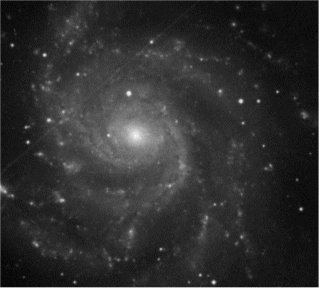 |
Common Name: Pinwheel Galaxy, M101, NGC 5457
Spiral galaxy structure with bright knots. APOD
Image
Constellation Ursa Major
Magnitude: 7.70
RA, Dec: 14h 3m
RA: 14h 3m 11.9s , Dec: 54d 21m 0s N (E2000)
**** Observation Log ****
|
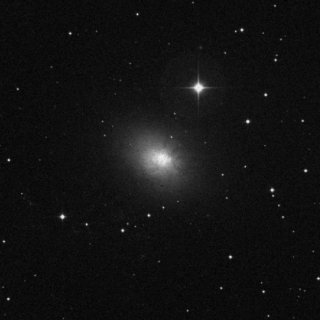 |
NGC 3077
Other description: Elongated galaxy.
Constellation: UMa
Dreyer description: Considerably bright, considerably large, much brighter middle, round with ray.
Magnitude: 9.9
RA: 10h 03m 46.5s Dec: +68░42'30"
RA: 10h 03m 18.0s Dec: +68░44'00" (Epoch 2000)
**** Observation Log ****
Viewed this Irregular galaxy with a 6" Newtonian. The 7.87
magnitude star, SAO 15054 is just to the west. M81 and M82 show up in
the same FOV with low power eyepieces.
|
 Back to top...
Back to top... |
|
|
VIRGO (VER-go) The Virgin. Genitive: Virginis
(VER-gin-is). Abbreviation: Vir |
 |
Sombrero Galaxy, M104, NGC 4594
Dreyer description: Remarkable!, very bright, very large, extremely extended 92░, very abruptly much brighter middle nucleus; = M104.
Magnitude: 8.6
RA: 12h 39m 59.3s
Dec: -11░37'22" (Epoch 2000)
**** Observation Log ****
04/2002 - The Sombrero Galaxy in Virgo: What a beautiful sight. I don't
think I could see the dark lane in an 8", but neat all the same. |
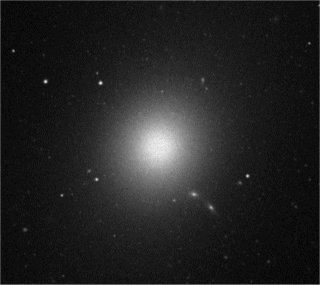 |
Smoking Gun, M87,
NGC 4486
Round galaxy with bright core. Smoking
Gun APOD
Constellation Virgo
Magnitude: 8.60
RA, Dec: 12h 30m 48.0s , 12d 24m 0s N (E2000)
**** Observation Log ****
05/2002 - This huge Elliptical Galaxy is reported to contain a massive
black-hole fueling a jet of super-heated material outward. |
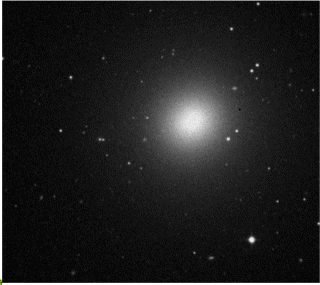 |
M84,
NGC 4374
Round galaxy with bright core. APOD
of super massive black hole in center of M84
Constellation Virgo
Magnitude: 9.30
RA, Dec: 12h 25m 6.0s , 12d 53m 0s N (E2000)
**** Observation Log ****
05/2002 - |
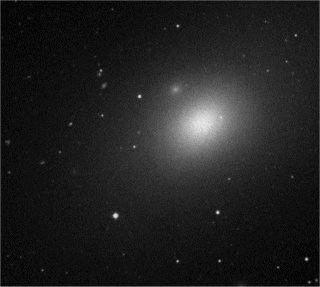 |
M86,
NGC 4406
Round galaxy with bright core.
Constellation Virgo
Magnitude: 9.19
RA, Dec: 12h 26m 12.0s , 12d 57m 0s N (E2000)
**** Observation Log ****
05/2002 - |
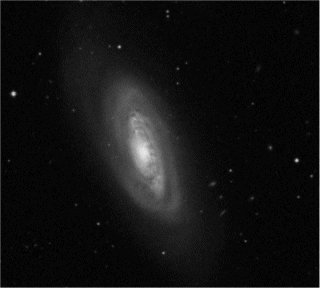 |
M90,
NGC 4569
Very elongated galaxy with bright core.
Constellation Virgo
Magnitude: 9.50
RA: 12h 36m 48.0s Dec: 13d 10m 0s N (E2000)
**** Observation Log ****
|
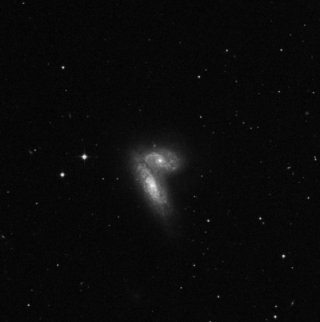 |
Siamese Twins, NGC 4567 & NGC 4568
Other description: Elongated galaxy close companion.
Constellation: Vir
Dreyer description: Very faint, large, northwest of double nebula (4568 at 160░ +/-).
Magnitude: 11.3
RA: 12h 36m 30.0s Dec: +11░15'00" (Epoch 2000)
**** Observation Log ****
|
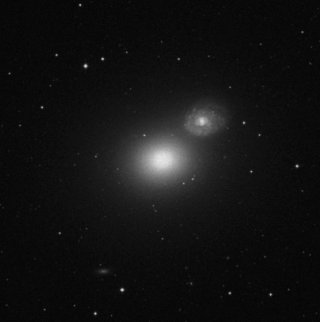 |
M60, NGC 4649
Constellation: Vir
Dreyer description: Very bright, pretty large, round, eastward of double nebula; = M60.
RA: 12h 43m 40.2s Dec: +11░32'58" (Epoch 2000)
**** Observation Log ****
|
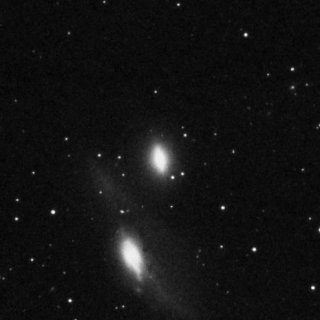 |
The Eyes, The Nonet, NGC 4435,
Other description: Elongated galaxy with bright core.
Constellation: Vir
Dreyer description: Very bright, considerably large, round, northwest of 2.
RA: 12h 27m 42.0s Dec: +13░05'00" (Epoch 2000)
**** Observation Log ****
|
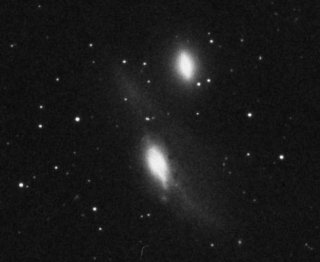 |
The Eyes, The Nonet, NGC 4438
Other description: Very elongated galaxy with bright core.
Constellation: Vir
Dreyer description: Bright, considerably large, very little extended, resolvable, but mottled, southeast of 2.
Magnitude: 10.1
RA: 12h 27m 48.0s Dec: +13░01'00" (Epoch 2000)
**** Observation Log ****
|
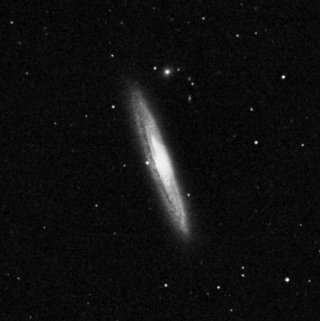 |
NGC 4216
Other description: Edge on galaxy with bright core.
Constellation: Vir
Dreyer description: Very bright, very large, very moderately extended 17░, abruptly brighter middle nucleus.
Magnitude: 10.0
RA: 12h 15m 54.0s Dec: +13░09'00" (Epoch 2000)
**** Observation Log ****
|
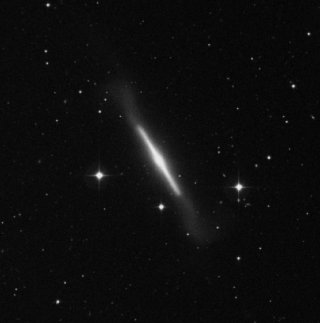 |
NGC 4762
Other description: Edge on galaxy dusty.
Constellation: Vir
Dreyer description: Pretty bright, very moderately extended 31░, 3 bright stars south, eastward of 2.
Magnitude: 10.2
RA: 12h 52m 54.0s Dec: +11░14'00" (Epoch 2000)
**** Observation Log ****
|
 Back to top...
Back to top... |
|














 Back to top...
Back to top...



















































